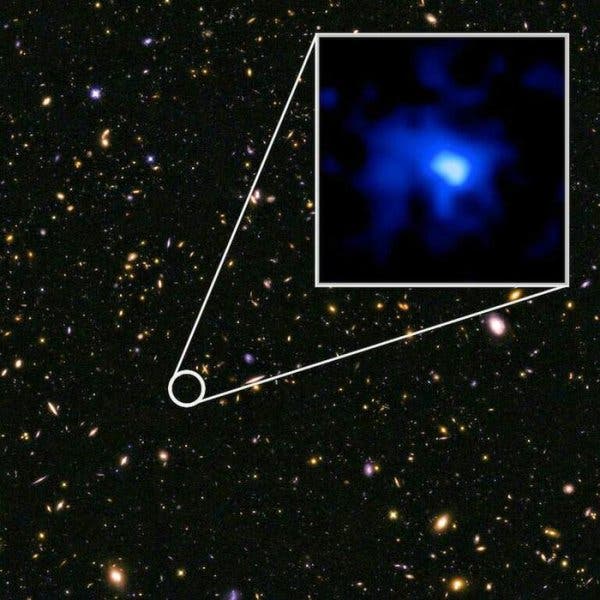A team of astronomers from Yale and the University of California-Santa Cruz have looked back in time, discovering a galaxy that was formed when the Universe was only 5% of its current age. This is now the farthest, and youngest galaxy known to date.

Credit: NASA, ESA, P. Oesch and I. Momcheva (Yale University), and the 3D-HST and HUDF09/XDF teams
When we look at something through a telescope, we don’t see it as it is now, we see it as it was when light coming from it started its journey towards us. It takes light from the Sun 8 minutes to reach us, so when we view the Sun from Earth, we see it as it was 8 minutes ago. But it took light from that galaxy billions of years to reach us, so astronomers are effectively taking a glimpse in the past.
The galaxy, named EGS-zs8-1 is one of the brightest ones we know, and it emerged just 670 million years after the Big Bang. The light from it took 13 billion years to reach us, but because the Universe is continuously expanding, it’s estimated that the galaxy is now over 30 billion light years away from us.
“It has already built more than 15% of the mass of our own Milky Way today,” said Pascal Oesch, a Yale astronomer and lead author of a study published online May 5 in Astrophysical Journal Letters. “But it had only 670 million years to do so. The universe was still very young then.” The new distance measurement also enabled the astronomers to determine that EGS-zs8-1 is still forming stars rapidly, about 80 times faster than our galaxy.
This finding is even more remarkable as only a handful galaxies from the early stages of the Universe were accurately measured in terms of distance to the Milky Way.
“Every confirmation adds another piece to the puzzle of how the first generations of galaxies formed in the early universe,” said Pieter van Dokkum, the Sol Goldman Family Professor of Astronomy and chair of Yale’s Department of Astronomy, who is second author of the study. “Only the largest telescopes are powerful enough to reach to these large distances.”
The moment at which this galaxy was captured in time was a very significant one for our Universe – it was a time when the hydrogen between galaxies was transitioning from a neutral state to an ionized state.
“It appears that the young stars in the early galaxies like EGS-zs8-1 were the main drivers for this transition, called reionization,” said Rychard Bouwens of the Leiden Observatory, co-author of the study.
The discoveries excited astronomers who believe that they will make many more similar discoveries in the future.
“Our current observations indicate that it will be very easy to measure accurate distances to these distant galaxies in the future with the James Webb Space Telescope,” said co-author Garth Illingworth of the University of California-Santa Cruz. “The result of JWST’s upcoming measurements will provide a much more complete picture of the formation of galaxies at the cosmic dawn.”
Journal Reference: P. A. Oesch, P. G. van Dokkum, G. D. Illingworth, R. J. Bouwens, I. Momcheva, B. Holden, G. W. Roberts-Borsani, R. Smit, M. Franx, I. Labbé, V. González, D. Magee. A SPECTROSCOPIC REDSHIFT MEASUREMENT FOR A LUMINOUS LYMAN BREAK GALAXY ATz= 7.730 USING KECK/MOSFIRE. The Astrophysical Journal, 2015; 804 (2): L30 DOI: 10.1088/2041-8205/804/2/L30


